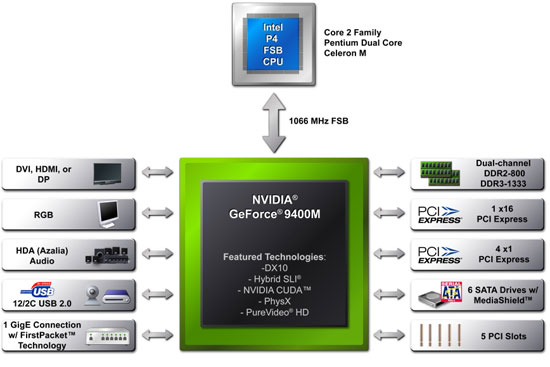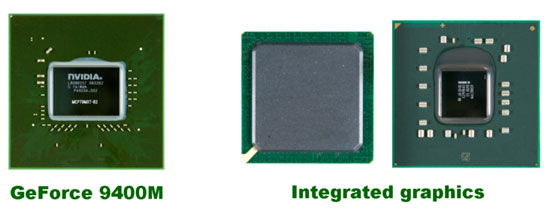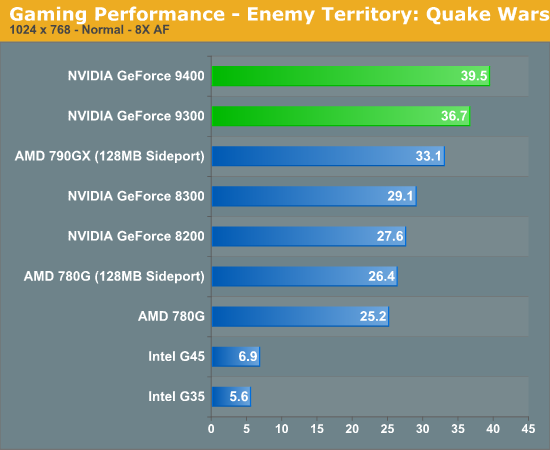Apple's Redesigned MacBook and MacBook Pro: Thoroughly Reviewed
by Anand Lal Shimpi on October 22, 2008 12:00 AM EST- Posted in
- Mac
The NVIDIA Move: The GeForce 9400M
Every now and then some interesting hardware stuff happens in the Apple world and I get all excited because I get to merge Apple coverage with PC hardware coverage; yippee.
For the uninitiated here's a quick rundown of the basic silicon in a computer: you've got a CPU, a GPU, I/O and main memory, and they all need to talk to one another. The role of the chipset is to provide some basic logic for all of these parts to communicate with one another:

Over time, more and more functionality got integrated into the chipset. Sound, video and ethernet are all part of any modern day chipset. In some cases the chipset is a combination of two chips and in others it's all one single chip.
NVIDIA used to brand its chipsets nForce and its graphics processors GeForce. When AMD bought ATI, NVIDIA realized it needed to strengthen its chipset brand so it began calling both its chipsets and graphics processors GeForce. Starting at the beginning of 2008, all NVIDIA chipsets included integrated graphics so the GeForce brand was justified.
The GeForce 9400M is the mobile variant of the GeForce 9400 chipset, which just launched last week. It's a single chip chipset with integrated graphics, giving it an inherent advantage over Intel's solution: it requires less motherboard real estate.

Intel's G35, which was used in the previous generation MacBook and MacBook Pro is composed of the G35 GMCH and the ICH9M. The GMCH was built on a 90nm process while the ICH was actually built on a 130nm process. The chips worked just fine but they consumed too much power and took up much more real estate on the motherboard. In a desktop that's not a problem, but in a notebook you're more space constrained.
NVIDIA's chipset reduces the size of the motherboard but it also reduces power consumption. Intel's G35 was built on a 90nm and 130nm process as I just mentioned; while G45 is built on 65nm for the GMCH, the ICH is still 130nm (not 90nm as I originally assumed). NVIDIA's GeForce 9400M is a 65nm chip; with good power management it should be similar in power consumption to G45 if not lower.
NVIDIA's GeForce 9400M is smaller, consumes less power than G35 and at worst the same amount of power as G45, but on top of all of that it's a lot faster than anything Intel has to offer. Take a look at this chart from last week's GeForce 9300 review:

The GeForce 9400M is far from a hardcore gaming GPU; you can't run most new games at high quality settings and get smooth frame rates, but older games will actually run relatively well on this thing. A bunch of us still play Command & Conquer 3, and instead of setting up a bunch of systems we just game on laptops. The system requirements aren't tremendous but playing on anything with G35/G45 isn't exactly satisfying; the GeForce 9400M is enough to make that game look decent and play okay. And herein lies the biggest upgrade to the new MacBook and MacBook Pro: if you happen to have Windows loaded on these machines, the gaming performance of the integrated graphics is much improved. These aren't gaming machines but they are much better than before for less stressful titles. I'd suggest looking at the GeForce 9300 review for a good idea of where NVIDIA's gaming performance stands but you're basically looking at playability at 800 x 600 or 1024 x 768 depending on the detail settings of whatever title you're playing.
Faster Exposé and Coverflow?
The GeForce 9400M, like Intel's GMA X3100 (the graphics core used in the previous generation MacBook), has no local framebuffer - instead it relies on carving out a portion of your system memory to use for its own needs. The GeForce 9400M uses the chipset's dual-channel DDR3-1066 memory controller, yielding around 17.1GB/s of memory bandwidth compared to the 10.7GB/s offered by the previous generation's dual-channel DDR2-667 memory controller.
GPU accelerated features of OS X such as Exposé and Coverflow aren't particularly processing power constrained as they ran just fine on the GMA X3100 used in the older MacBooks; memory bandwidth actually matters more here. Exposé feels slightly faster with 20 open windows on the new MacBook than on the old one; the animation is a tad smoother. The issue here is that the MacBook's resolution hasn't gone up, it's still stuck at 1280 x 800 - meaning the memory bandwidth requirements for smooth Exposé and Coverflow haven't changed. The same is true for things like Coverflow; at best it's marginally faster on the new MacBook.
Moving up to 40 windows, the gap between the GMA X3100 and the GeForce 9400M remains small but noticeable. But crank it up to 60 open windows and Exposé stutters on the GMA X3100 while it's still fairly smooth on the GeForce 9400M. I suspect this may be due to the 9400M having 256MB of system memory set aside for it compared to 144MB by the GMA X3100, although both should be able to grow their memory partition as needed without incurring a terrible penalty.
At 80 windows the GMA X3100 is unbearable when activating Exposé and both the MacBook's GeForce 9400M and the Pro's GeForce 9600M get choppy, but nowhere near as bad as the Intel solution. The 512MB GeForce 9600M will probably do a bit better with 80 windows but at 60 or less both of the NVIDIA solutions do well. With only a few windows open it's tough to tell the difference between the NVIDIA GPUs and the previous generation Intel offering, but keep a bunch of things open and you'll quickly appreciate the new mGPU.










66 Comments
View All Comments
plonk420 - Thursday, October 23, 2008 - link
could anyone test this with the new (and even old) Mac Book Pro to test for CPU usage?http://www.megaupload.com/?d=ADFYX083">http://www.megaupload.com/?d=ADFYX083
h.264 high profile (QT supports this now, right?) level 4.1 720p60, fairlight/the black lotus's demo Only One Wish (2nd place at Intel's second demo compo) .. has some really handsome bitrate spikes :D ~mid 20s mbps spikes (but not as good as the 60mbit spikes in a 6 or 8mbit (average) encode of ASD's Antisize Matters)
michaelheath - Thursday, October 23, 2008 - link
Having spoken to a few Apple developers I know, the reason for this oddity is Nvidia's software implementation for Mac OS 10.5. While the ideal situation was for them to be able to switch on the fly, the agreement between Apple and Nvidia to develop for the new MacBooks and MacBook Pros happened so quickly it left little time to create a proper application that would allow for this (think of how you had to restart your computer to turn SLI on or off: same slapdash type of programming).The hope is that quick-toggling between integrated and dedicated graphics will come with Mac OS 10.6 as it may be too large of an update to patch Mac OS 10.5. It also makes sense in this aspect as Mac OS 10.6 also includes OpenCL GPGPU algorithms, which Nvidia is already promoting and developing under their CUDA platform.
RDO CA - Thursday, October 23, 2008 - link
On my Thinkpad T-400 with switchable graphics all that is needed to switch is to go to the taskbar icon and click switchable graphics and choose what you want and the screen goes dark for a second and thats it.cliffa3 - Thursday, October 23, 2008 - link
I'll test it sometime this week, but on my Lenovo T61 it seems like I get much more life out of Ubuntu than I do Vista 64-bit. Could be a windows thing in general, not just something that OS X does better.How was the battery life comparison between XP and Vista?
PilgrimShadow - Thursday, October 23, 2008 - link
Anyone know if the 9400M and 9600M appear in Vista's Device Manager?TallCoolOne - Thursday, October 23, 2008 - link
I bought the new 2.0GHz MacBook last week as my first Mac and can say I'm not disappointed. The whole chassis feels as solid as, well, a block of aluminum! As Anand said, it feels like you get what you paid for. I actually like the multi-touch gestures, such as swiping with 3 fingers to flip pages and for back/forward when web browsing. I'd like to see iTunes also support that gesture. Two finger scolling is another great feature not mentioned in this article. What I don't like though is the stiffness of the mouse click. It takes far more pressure than any mouse and that required pressure is uneven in different areas of the trackpad. Pressing near the top requires more pressure than near the bottom. As for lack of standard SSD, Anand, perhaps you're a little too spoiled by that speed! I would not expect that as standard on even the fastest MacBook Pro at current prices. That is, unless you'd like to see the asking price for a MBP $500-600 more than it is now.vlado08 - Thursday, October 23, 2008 - link
It is interesting was vista side panel running during the test. Also was this fresh install of vista os. If it was fresh then was the indeing enabled.vlado08 - Thursday, October 23, 2008 - link
edit indeing - indexingjmpt2 - Thursday, October 23, 2008 - link
Very interesting to read your conclusions about better power management in MacOS vs Vista. This matches my experiences running Vista on the BootCamp partition of my Core Duo MacBook, and is the first time I've seen this discussed anywhere on the web. I found that with a main battery in quite poor condition after two years constant use, it became impossible to use Vista on battery power for more than a minute without the battery deciding it was empty and putting the machine into sleep mode. Under MacOSX the system could still be used for 30min+ (light use) before the same thing happened.I'd come to the conclusion that Apple were deliberately playing games with the ACPI tables to confuse Vista's power management code and make their own OS look better. This seemed to be supported by the fact that Vista is unable to correctly detect the charging state on my MacBook - running on battery power it would always report "Connected to mains, not charging". Does it still work that way on the latest MacBooks? In any case, your data does seems to suggest the problem is a more general issue with Vista. Sounds like you should investigate further...
BZDTemp - Thursday, October 23, 2008 - link
I wonder if OS X lasting longer on a battery can be transfered to the world of none portable?In other words say I run OS X on my daily, none laptop, work machine doing surfing, writing and perhaps listening to music(FLAC prefered over MP3) or even watching an episode of The Daily Show. Will this draw less power from the wall with a PC running OS X than with the same machine running Windows (and is there a difference between Windows versions). Also Linux should be included in the test.
Imagine the perspective - with the whole green computing movement this could really make a difference not just in the server rooms.
Please do check this out - this is not only interesting for us geeks but could make Anandtech something referred to by none-tech news media.